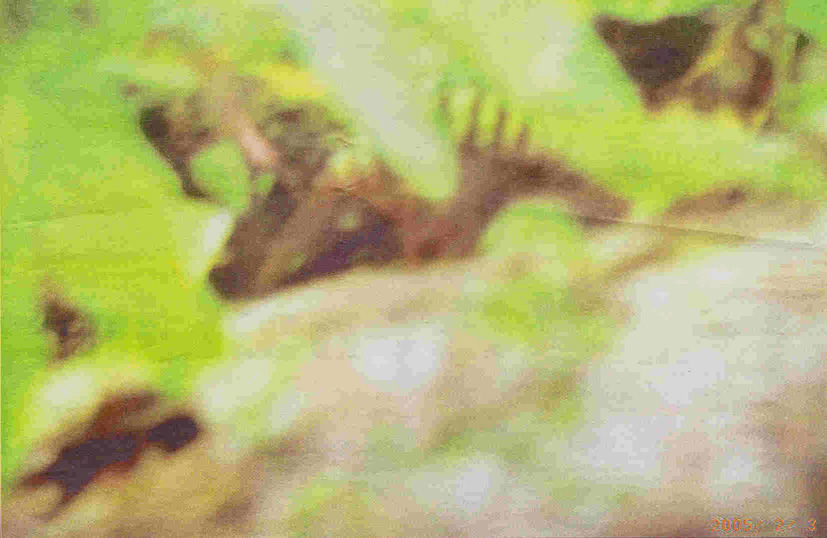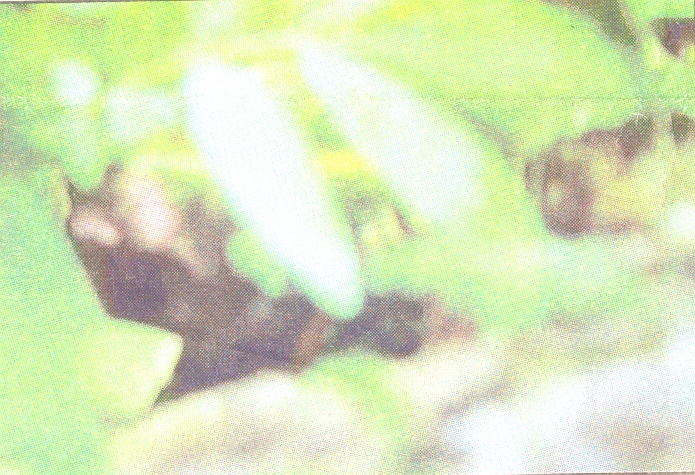Emmerichs thylacine
The Emmerichs thylacine photographs
The Emmerichs photographs. Copyright: Klaus Emmerichs.
The Emmerichs photographs, and derivative works, were removed from the former version of this website (at www.wherelightmeetsdark.com) in 2006 on request of Klaus Emmerichs. They were republished on 12 June 2019 under the defence of Fair Dealing under Australian copyright law. The original images and their elements as incorporated in derivative works are presented as they were published in the print version of Tasmanian newspaper, the Sunday Tasmanian in 2006. An attempt was made to contact Mr Emmerichs on 17 Mar 2017 ahead of the re-publication of these images but he could not be reached. For full details on how WLMD respects and supports copyright, please refer to the Terms and conditions of use. This note added 12 June 2019.
Overview
In February 2005, German tourists to Australia Klaus Emmerichs and partner Birgit Jansen claimed to have photographed a live Tasmanian tiger (thylacine) in Tasmania.
News broke in the media. The couple returned to Germany, leaving Klaus' brother to handle enquiries.
The 2 photographs were shown to experts in Tasmania. The initial reaction was that they showed a thylacine but there was no certainty that the photos were genuine.
Soon after, professional opinion began to change. Questions were raised about the similarity between Emmerichs' thylacine and an animal photographed in the 1930s by David Fleay.
There were also unanswered questions about the timestamps on those 2 images being recorded in a different display format than that of other images in the same sequence.
Mr Emmerichs contended that the fact the images were recorded on his camera's memory (A Caplio), rather than a data storage card, indicated the photographs were genuine. Seemingly in response, the Sydney Morning Herald published genuine photographs of a cardboard-cutout thylacine to show that Emmerichs' reasoning does not guarantee the images are not a hoax.
Finally, the colour quality of the thylacine photos differed significantly from other photographs in that sequence. Emmerichs claimed the camera was incorrectly set to "night mode", thus resulting in the discrepancy.
Where Light Meets Dark
The Emmerichs photos were the inspiration behind launching the Where Light Meets Dark website. I conducted a number of geometric analyses of the photographs and contended that they were genuine photographs of a real-life scene.
This left only the question of whether it was a live thylacine in that scene, or some other object such as a taxidermy or cardboard-cutout.
Although I met with Klaus and Birgit in 2007, they would only permit me to view the image on the camera itself. Thus there was not any opportunity to look at the image in detail. I did view the other images in the sequence either side, and observed the discrepancies in colour quality that had been referred to by others.
Publication of the photographs
The first publication of the photographs was made 14 months after their initial announcement. Conditions were placed over the publication, which was in a Tasmanian newspaper. Publication outside Tasmania would incur an additional licence fee.
At the same time a magazine in Europe was also granted permission to publish the photographs.
Popular cryptozoology blog, Cryptomundo had the images briefly online at this time and was asked to remove them by the licence holder in Europe. Where Light Meets Dark had published numerous versions of the images also, each with notes and diagrams overlaid to illustrate various features of the photographs. WLMD also removed the images from publication at this time.
In 2009 Emmerichs granted permission to the US television show Monster Quest to include the photographs in its episode, Isle of the Lost Tiger.
The Emmerichs photographs, and derivative works, were removed from the former version of this website (at www.wherelightmeetsdark.com) in 2006 on request of Klaus Emmerichs. They were republished on 12 June 2019 under the defence of Fair Dealing under Australian copyright law. The original images and their elements as incorporated in derivative works are presented as they were published in the print version of Tasmanian newspaper, the Sunday Tasmanian in 2006. An attempt was made to contact Mr Emmerichs on 17 Mar 2017 ahead of the re-publication of these images but he could not be reached. For full details on how WLMD respects and supports copyright, please refer to the Terms and conditions of use. This note added 11 June 2019.
Analyses
There is a wealth of articles on this website related to the Emmerichs thylacine. The majority were written prior to 2008. Soon after their initial publication, all images containing the Emmerichs photographs were removed on request of Mr Emmerichs. You can read these articles below.
| Analysis | Description |
|---|---|
| Backstory | A short summary of the backstory. |
| First comparison | A first look at the Emmerichs photographs notes very slight differences in the animal's posture between shots. |
| 1930s Fleay photograph overlay by Alton Higgins | Alton Higgins of Mid America Christian University used differing levels of opacity to overlay Fleay's 1930s photograph with the Emmerichs thylacine. The result was a nearly perfect match. |
| Another Fleay comparison, by WLMD | More detailed study of the relative tonalities surrounding various features of the animal's fur patterns supports the view that the Emmerichs thylacine is nearly identical to the 1930s Fleay photograph. It is noted that the earlier examination (link above) contradicts these latest findings as it appears the animal's leg is in a slightly different position in each Emmerichs photograph. |
| Can the Emmerichs photo be dismissed as a copy of Fleay's based on stripe pattern? | The Fleay overlays created by Alton Higgins (link above) were designed to show that the Emmerichs photos do contain a thylacine. (Many couldn't distinguish it from the foliage). Instead, they showed a nearly perfect match and many felt they proved Emmerichs' thylacine to be a hoax. This argument is strengthened by Robert Paddle's research on thylacine stripes which shows that individuals had remarkable variability in striping patterns. In this article, Higgins performs another analysis comparing stripe spacing along the spines of a number of thylacines in photographs. The conclusion is that along the dorsal surface, most thylacines display a similar number of similarly spaced stripes. Paddle's research referred to the end of the stripes and not explicitly the spinal region. Although the evidence of a hoax appears strong, it is is not conclusive and the Emmerichs photographs cannot be dismissed on the basis of the Fleay overlays alone. |
| Geometric analysis explained | This article demonstrates the logic behind the geometric analysis that was conducted by Where Light Meets Dark. Because Mr Emmerichs physically moved between taking the two photographs, the elements in each photograph change relative position. The distance of movement is inversely proportional to the distance from the camera. As a result, the geometric properties can be used to model the layering order of elements in the photographs. |
| Summary of the analysis | A summary of the analysis to date at that point. It includes conclusions that the scene is consistent between shots and that the photographs are of a real three dimensional scene (and not digital constructions) (amongst other conclusions). |
| This author's experience photographing cryptids in the wild | Whilst I was photographing fungi in an urban bush park of 45 hectares, a swamp wallaby made an appearance. This sighting was most unexpected for the area. It took me 10 minutes in a very confined space to secure "evidentiary" photographs which turned out to be of very poor quality. I used the experience to make a comparison with the quality of Klaus Emmerichs' thylacine photographs. |
| Second summary - closing thoughts | A second short summary of the analysis to that point. |
| 2007 expedition to coincide with Emmerichs thylacine anniversary | I had begun plans for a trip to Tasmania to search for the thylacine on the anniversary of Emmerichs' sighting. The choice of date was based on Paddle's evidence that thylacines may have been migratory. To that point I did not know the exact location of Emmerichs' thylacine and as my attempts to secure funding for the trip failed, the expedition did not proceed. |
| Further thoughts | A clarification of the copyright on the photos and a summary of my reasons at that time for believing the Emmerichs photos to likely be genuine. |
| Seeing the photographs first hand | In 2007 I personally met Klaus Emmerichs and Birgit Jansen and had the opportunity to view their photographs first hand, albeit on the screen of their camera only. In addition they shared many other travel photographs, videos and stories. This article summarises the meeting and includes a photograph of Klaus and Birgit with the original Ricoh Caplio camera containing the thylacine images. |
Revisions
12 June 2019 - Section "The Emmerichs thylacine photographs" added.
11 June 2019 - Note added regarding republication of images and copyright.

